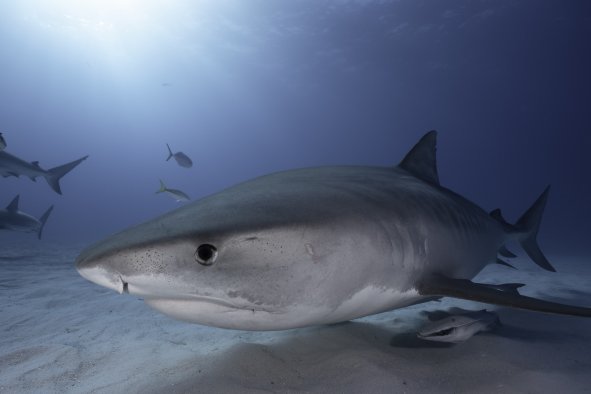A fossil site of "unique importance" has shed light on a lost prehistoric ecosystem where early dinosaurs roamed more than 200 million years ago.
For a study published in the Proceedings of the Geologists' Association, a team of paleontologists described and analyzed fossil beds at Lavernock on the south coast of Wales—one of the constituent countries of the United Kingdom.
These fossil beds are dated to the Triassic period, which lasted from roughly 252-201 million years ago. It was in this period that dinosaurs first appeared.
"The bone beds there have been known since the 19th century, but had yet to be investigated by modern paleontologists," Owain Evans, lead author of the study with the University of Bristol in the U.K., told Newsweek.
"We hoped to officially record the geological strata, and further understand the fossil fauna—what was the local ecology like 200 million years ago?"
Initially, Evans and colleagues conducted fieldwork at Lavernock in an attempt to pin down the exact location of the bone bed and to collect samples.
During the fieldwork, the team not only discovered the fossil beds that 19th century scholars wrote about, but also a secondary bed featuring a different set of animal remains and geological type.
While in the field, the researchers also collected two "significant" fossils, Evans said. The first was an osteoderm (a sort of scaly armor) from a placodont, a kind of extinct marine reptile. The second was a bone from a coelacanth, an ancient group of fish, some species of which still survive today.
"Both of these fossils are very rare in the U.K., so they add to the unique importance of the fossil fauna at Lavernock," Evans said.
The second phase of the study took place in the lab and in the collections of the National Museum of Wales (NMW).
"In the lab, I processed samples that had been collected from the field and extracted the tiny microfossils that are sealed within the rock," Evans said. "These fossils include the teeth, scales and bones of sharks and fish.
"By looking at the microfossils, we can fully account for all of the animals which lived in this shallow sea during the Rhaetian," which is the last age of the Triassic. "In the collections at the NMW, I made a full inventory of every fossil that had been collected from Lavernock, some of which go back to the 1870s."
A number of these fossils had been misidentified, particularly a large vertebra, which had been cataloged as belonging to an amphibian, but which actually likely came from a herbivorous dinosaur known as plateosaurus. This dinosaur is an ancestor of the sauropods, a group that includes the largest land-dwelling animals ever to walk the Earth.
The researcher was also able to identify another vertebra, as well as a finger bone, from a predatory theropod—a group of carnivorous dinosaurs.
"The fossils, although fragmentary, are very significant, as they belong to some of the earliest dinosaurs that walked the shores of the U.K.," Evans said.
"There were also numerous other bits of bone, which were likely pieces of dinosaur material, but were not complete enough for positive identification."
The results of the study indicate that Lavernock Point is host to a dense bone bed dated to the Rhaetian age—a time when this region of what is now the United Kingdom consisted of a tropical archipelago of islands in a warm shallow sea.
The fossils enabled the researchers to reconstruct a complex ecosystem in which large marine reptiles shared the waters with a diverse array of fish and sharks, while a significant population of dinosaurs made their home on the islands.
"Occasionally, large storms dragged the bones of these animals into a tidal zone and deposited them in the mud—to be fossilized and finally uncovered 200 million years later," Evans said.
"The fact that we are finding so many dinosaur bones in a marine deposit suggests that they were numerous enough on the surrounding land that their bones frequently washed into the sea."
"The volume of dinosaur fossils at Lavernock tells us that by the end of the Triassic, several groups of these animals lived across the archipelago. Herbivorous ancestors of the large bodied, long-necked sauropods would have browsed the local flora, while avoiding predatory theropods."
Judging by the size of some of the bones that the researchers found, some of these dinosaurs were reasonably large—not quite the giants that evolved in later periods, but still substantial.
"A few species are known from the Triassic of South Wales, but the Lavernock fossils point towards animals that are quite a bit larger than anything that has been found before, which is exciting," Evans said. "Triassic dinosaur fossils are rare, not just in the U.K., but globally."
"Our account highlights the importance of Lavernock, not only as one of the most crucial dinosaur sites in the U.K., but across the world. Here, we are able to study an early period in dinosaur evolution that has often evaded paleontologists. We are now working on fleshing out the dinosaur fauna a little more—because it's a rare chance to study a rich dinosaur assemblage from the Triassic."
Do you have an animal or nature story to share with Newsweek? Do you have a question about paleontology? Let us know via science@newsweek.com.
Disclaimer: The copyright of this article belongs to the original author. Reposting this article is solely for the purpose of information dissemination and does not constitute any investment advice. If there is any infringement, please contact us immediately. We will make corrections or deletions as necessary. Thank you.



